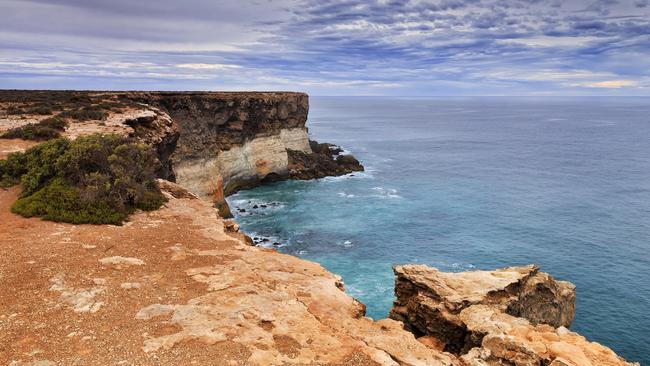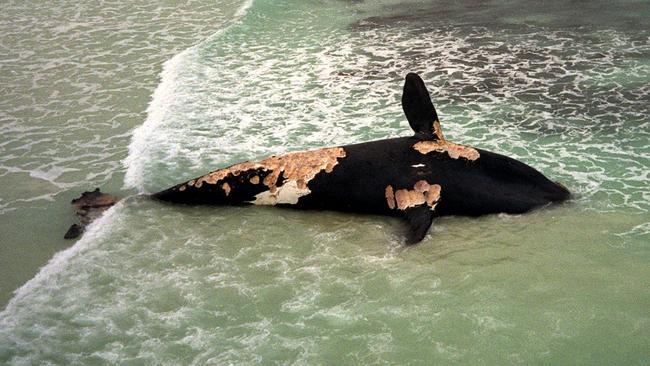New modelling shows oil is only one of many threats to the Great Australian Bight
Threats to the Great Australian Bight are real and already happening, but oil drilling is only one of many, as Miles Kemp reports.
SA News
Don't miss out on the headlines from SA News. Followed categories will be added to My News.
- Bight oil drilling special report: The cases for and against
- Poll suggests Bight drilling is opposed by most in SA
- But several regional mayors back the drilling plan
- Equinor lashes opponents of project’s environmental risks
- Wilderness Society outlines its position on the proposal
One side of the Great Australian Bight oil drilling debate would have you believe it is a pristine, almost untouched environment, while the other suggests oil production in the region is not out of the ordinary and is almost without risk.
But what if neither side was right, and The Bight represents another type of expansive ecosystem entirely.
What if it is facing more likely and predictable threats from humans than the possibility of an oil spill, and threats equally deserving of our attention?
That is the scenario painted by Australia’s leading experts on The Bight, after a five-year study into the region’s so-called ‘blue economy’ or marine industries, the threats ranged against it, its strengths, weaknesses and connections between living things.
The Great Australian Bight Research Program — based on extensive computer modelling work between 2013 and 2017 — combined expertise from CSIRO, the South Australian Research and Development Institute (SARDI), the University of Adelaide, and Flinders University.

The program collected extensive information on every aspect of The Bight, measuring the abundance and movements of key species, food sources, habitats and looking into the risks and stresses on the area.
All of this work was brought together in a computer model of the system, which captures its connections, ups and downs and responses to disturbance.
Rather than only measuring what an oil spill would do, other scenarios were also run through the computer modelling; climate change, fishing, disease, and aquaculture.
The Bight, they found, is far from the untouched and risk-free ecosystem that we are told it is in the glossy tourism brochures and campaign rhetoric of the green side of the oil debate.
“Despite a relatively low level of use compared to places where the coasts are more populated such as New South Wales, the ecosystem already carries the fingerprints of human use,’’ lead researcher and CSIRO expert Dr Beth Fulton explains.
“The Bight may be stunningly beautiful and rich but it is not ‘untouched’.
“Human industries and climate change have already modified The Bight ecosystem.’’
The study is likely to win no friends on either side of The Bight oil fight, in which explorer Norwegian oil giant Equinor is seeking Federal Government approval to drill, and is lined up against a coalition of greenies, surfers and their apparel manufacturers, local councils, the fishing industry and tourist industry.
One side argues oil drilling would be “business as usual” and the other that The Bight is a “pristine wilderness”.
Neither case is supported by the research.
Rather all human activities in the region, but especially global warming and climate change, have already altered the environment significantly. They also pose a significant ongoing threat to the region.
The report concludes: “Climate and fisheries pressure have some of the greatest potentials to influence the entire ecosystem, although in different ways. The fisheries effects tend to decrease with distance from shore; while climate has a footprint that encompasses the entire
region, effecting species in a variety of ways and with differing outcomes for some
species compared to others. There will be ‘winners’ and ‘losers’”.
The modelling works by applying complex mathematical equations and computer scenarios to information collected from the environment, starting in the case of The Bight with the smallest and most abundant food source; tiny plant-like phytoplankton.
Stressors are then applied to the animals and plants. For example, a massive kill-off potentially caused by climate change of a major food source such as sardines. The effects on species are then calculated. A sardine kill off would have the largest effect on penguin numbers; down 20 per cent.
In comparison, in the scenario looking at what happens if there were an offshore shipping collision leading to an oil spill, the overall biomass in the area would decrease by 2-3 per cent. Onshore spills resulting in large coastal damage could lead to declines of 5 per cent.
After running their numbers, the scientists concluded in the future:
OIL spills from shipping would affect seabirds, fish and marine mammals, ultimately the whole ecosystem but likely only in a small area around the spill.
MORE fishing pressure would have the biggest impact on individual groups of animals.
OCEAN warming would have the greatest influence on the entire ecosystem of The Bight.

Dr Fulton says “wise management” of the entire ecosystem was one obvious priority for those in charge.
“Climate change and fishing have some of the greatest potentials to cause further change and influence the entire Bight ecosystem, although in different ways,’’ she says.
‘Wise management of the system’ and ‘sustainable use of The Bight’ are the major recommendation of the research according to Dr Fulton.
That and heeding another dire warning of where the planet is heading with global warming.
“If climate change creates frequent ‘extreme events’ — such as marine heatwaves or disease outbreaks — then The Bight ecosystem could change to the point the relative mix of species is very different to today,’’ she says.
“This is called a regime shift. At present such a large change is unlikely, but it is possible, especially if emissions remain high and climate change goes beyond the targets of the Paris Agreement (to reduce emissions).’’


